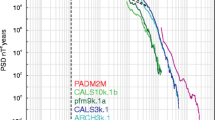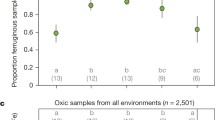Abstract
Replying to: H. Zhou et al. Nature 450, doi: 10.1038/nature06408 (2007).
Zhou et al.1 raise the possibility that the titanium (Ti) record at Lake Huguang Maar is controlled by local erosion and runoff to the lake, or through hydrological changes in the lake such as level fluctuations, rather than by changes in the inputs of airborne material2. The authors come to this conclusion by considering the Ti record in isolation. They ignore the redox-sensitive parameters of the S-ratio, total organic-matter content, the Mn/Fe ratio, and magnetic susceptibility records. We believe that their case against our interpretation of the Ti record is weak, and that their interpretation can be ruled out if the other measurements are taken into account2.
Similar content being viewed by others
References
Zhou, H., Guan, H. & Chi, B. Records of winter monsoon strength. Nature 450, 10.1038/nature06408 (2007)
Yancheva, G. et al. Influence of the intertropical convergence zone on the East Asian monsoon. Nature 455, 74–77 (2007)
Wang, W.-Y. et al. The two-step monsoon changes of the last deglaciation recorded in tropical Maar Lake Huguangyan, southern China. Chin. Sci. Bull. 45, 1529–1532 (2000)
Mahowald, N. et al. Dust sources and deposition during the last glacial maximum and current climate: A comparison of model and results with paleodata from ice cores and marine sediments. J. Geophys. Res. 104 (D13). 15895–15916 (1999)
Schettler, G., Liu, Q., Mingram, J. & Negendank, J. F. W. Palaeovariations in the East-Asian monsoon regime geochemically recorded in varved sediments of lake Sihailongwan (northeast China, Jilin province). Part 1: Hydrological conditions and dust flux. J. Paleolimnol. 35, 239–270 (2006)
Author information
Authors and Affiliations
Rights and permissions
About this article
Cite this article
Yancheva, G., Nowaczyk, N., Mingram, J. et al. Yancheva et al. reply. Nature 450, E11 (2007). https://doi.org/10.1038/nature06409
Published:
Issue Date:
DOI: https://doi.org/10.1038/nature06409
- Springer Nature Limited
This article is cited by
-
Magnetic granulometry of recent sediments from the Huguang Maar and its implication for provenience
Chinese Science Bulletin (2010)





